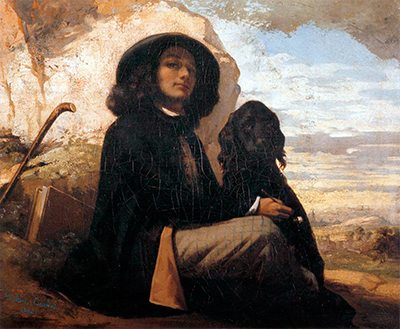Self-Portrait with a Black Dog is one of the earliest paintings by Gustave Courbet, arriving in 1842-1844 and starting off a lifelong series of artworks that depicted himself in a variety of poses and settings.
The composition in this painting reminds us of his early years, travelling around the French countryside with little more than a sketchbook and his dog to accompany him. His facial expression oozes self-confidence, something that he was never short of, even at this early age. This strength of personality was essential to his later success in Paris and his willingness to challenge the traditional art critics who would struggle to accept his own realist style. It is fair to say that his style of dressing in this portrait is somewhat bohemian, in keeping with his later dislike for elements of city life. Courbet also held strong socialist values that might be apparent in how he saw himself, even at this stage.
The painting was originally completed in 1842 but the artist decided to make adjustments to it around two years later. He did the same with some of his other paintings, too. The longest gap was a full decade. The artwork was eventually gifted to the Petit Palais in Paris by Juliette Courbet in 1909 and it remains there today. Its original title in French was 'Courbet au Chien Noir'. It is most likely that the scenery depicted in the background, on the right of the canvas, is of Courbet's local environment, where he grew up. Ornans itself features regularly in his work and was always his favourite place to be. Technical experts have pointed out how the sky was put together with the use of a knife, something that the artist continued to develop as a skill for many years later. The work was accepted by the Salon upon submission and ended a run of rejections which had previously frustrated his efforts to draw attention to his career.
The Petit Palais continues to display this significant artwork as part of their exceptional collection. They have a particularly strong selection of work from the Dutch Golden Age up to the late 19th century, including highlights from masters such as Rembrandt, Rubens, Nicolas Poussin, Fragonard, Ingres, Géricault, Delacroix, Courbet, Monet, Sisley, Pissarro, Cézanne and Rodin. It is yet another incredible art institution to be found in the city of Paris, which remains one o the centres of culture right across the world, alongside the likes of London, New York, Madrid and Rome.




